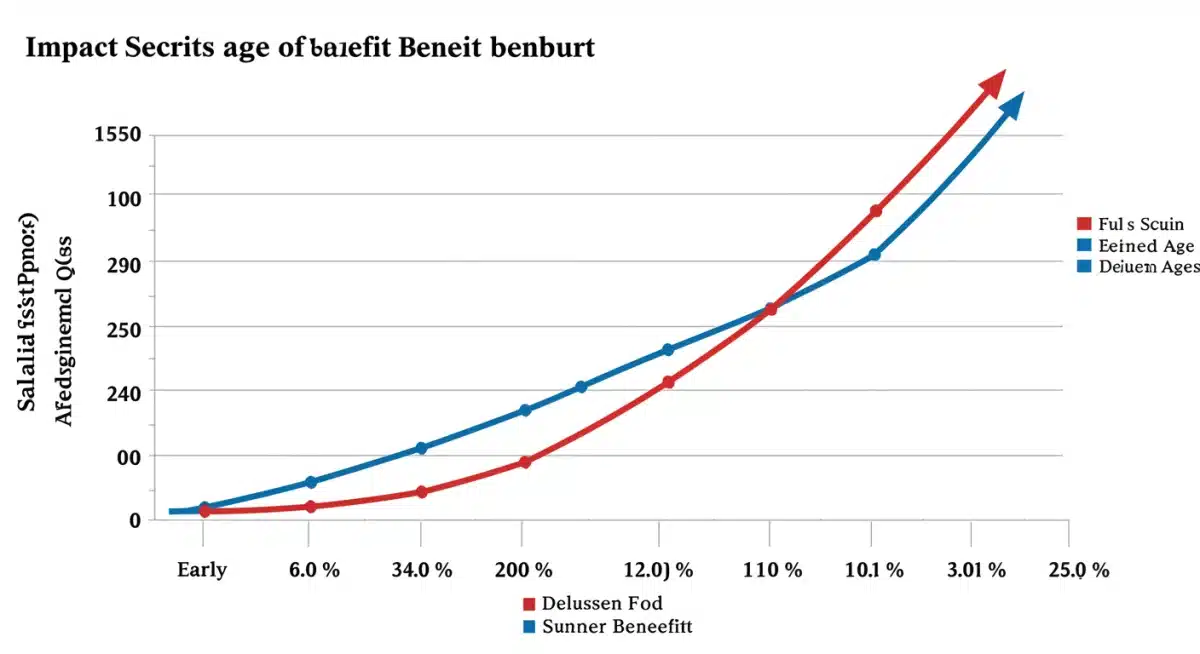Maximize Your 2025 Social Security Benefits: 5 Key Strategies

Anúncios
Maximizing your 2025 Social Security benefits involves strategic planning around claiming age, understanding cost-of-living adjustments, managing earnings, and leveraging spousal or survivor benefits for optimal retirement income.
For many Americans, Social Security represents a cornerstone of their retirement income. Understanding how to navigate its complexities and make informed decisions is paramount. This guide focuses on Maximizing Your Retirement Benefits: 5 Key Strategies for 2025 Social Security Optimizations, offering insights that can significantly impact your financial well-being in your golden years.
Anúncios
Understanding the Basics of Social Security in 2025
Before diving into optimization strategies, it’s crucial to grasp the fundamental principles governing Social Security benefits in 2025. These benefits are earned through years of work and tax contributions, providing a safety net for retirees, disabled individuals, and survivors. The amount you receive is primarily based on your highest 35 years of earnings, adjusted for inflation.
The Social Security Administration (SSA) regularly updates its rules and figures, which can influence your benefit calculations. For 2025, it’s expected that there will be adjustments to the Cost-of-Living Adjustment (COLA), earnings limits for those still working, and the maximum taxable earnings. Staying informed about these changes is the first step toward effective planning.
Anúncios
Key Social Security Terms to Know
- Primary Insurance Amount (PIA): This is the benefit you receive if you claim at your Full Retirement Age (FRA).
- Full Retirement Age (FRA): The age at which you are entitled to 100% of your Social Security benefits. For those born in 1960 or later, it’s 67.
- Cost-of-Living Adjustment (COLA): An annual increase in benefits to account for inflation, typically announced in the fall for the following year.
These terms form the bedrock of Social Security planning. A solid understanding empowers you to make strategic decisions that can enhance your retirement income. The landscape of Social Security is dynamic, so continuous learning and adaptation are essential for maximizing your benefits.
Strategy 1: Strategic Claiming Age – The Power of Delay
One of the most impactful decisions you’ll make regarding Social Security is when to start claiming your benefits. While you can begin as early as age 62, doing so results in a permanent reduction. Conversely, delaying beyond your Full Retirement Age (FRA) can significantly increase your monthly payments.
For each year you delay claiming benefits past your FRA, up to age 70, your benefit amount increases by a certain percentage, known as Delayed Retirement Credits (DRCs). These credits are substantial, often ranging from 7% to 8% per year. This means that waiting until age 70 could result in a monthly benefit that is 24% to 32% higher than what you would receive at your FRA.

Consider your health, other retirement income sources, and life expectancy when deciding your claiming age. If you anticipate a long retirement and have other funds to cover expenses in your early retirement years, delaying can be a powerful strategy. This decision should not be made lightly, as it has long-term financial implications.
Calculating Your Optimal Claiming Age
- Assess your financial needs: Can you comfortably live without Social Security for a few more years?
- Evaluate your health: If you have a family history of longevity, delaying might be more advantageous.
- Consult with a financial advisor: A professional can help model various claiming scenarios based on your unique situation.
The decision to delay claiming Social Security benefits is a personal one, but its potential to significantly boost your retirement income makes it a crucial strategy for 2025 Social Security optimization. Understanding the mechanics of delayed retirement credits is key to unlocking this potential.
Strategy 2: Navigating Spousal and Survivor Benefits
Social Security isn’t just for individual workers; it also provides benefits for spouses, divorced spouses, and survivors. These benefits can be a critical component of a couple’s or individual’s retirement plan, especially if one spouse has significantly higher earnings than the other.
A spouse can claim benefits based on their own work record or up to 50% of their spouse’s Full Retirement Age (FRA) benefit, whichever is higher. To claim spousal benefits, the primary earner must have already filed for their own benefits. Similar to individual benefits, claiming spousal benefits early can result in a reduced amount.
Important Considerations for Spousal Benefits
- Coordination is key: Spouses should strategically coordinate their claiming ages to maximize their combined benefits.
- Divorced spouse benefits: If you were married for at least 10 years and are currently unmarried, you may be eligible for benefits based on your ex-spouse’s record, even if they have remarried. Your ex-spouse’s benefits are not affected.
- Survivor benefits: Widows and widowers can receive up to 100% of their deceased spouse’s benefit. Claiming age for survivor benefits also impacts the amount received.
These rules offer significant opportunities for families to maximize their collective Social Security income. Understanding the nuances of spousal and survivor benefits, particularly in the context of 2025 regulations, can provide a substantial financial boost to your retirement planning. It’s not just about what you earned, but also what your family’s history allows.
Strategy 3: Managing Earnings While Receiving Benefits
Many individuals choose to continue working even after they begin receiving Social Security benefits. While this can provide additional income, it’s important to be aware of the earnings limit, which can temporarily reduce your benefits if you are below your Full Retirement Age (FRA).
For 2025, the Social Security Administration (SSA) will likely adjust the annual earnings limit. If your earnings exceed this limit before you reach your FRA, a portion of your benefits will be withheld. However, these withheld benefits are not lost; they contribute to a recalculation at your FRA, potentially increasing your future monthly payments.
Once you reach your FRA, the earnings limit no longer applies, and you can earn as much as you want without any reduction in your Social Security benefits. This provides flexibility for those who wish to continue working part-time or full-time in their later years without penalty.
Key Points on Earnings and Benefits
- Below FRA: Benefits are reduced if earnings exceed the annual limit.
- Year of FRA: A higher earnings limit applies, and the reduction rate is different.
- After FRA: No earnings limit; you can earn unlimited income without affecting benefits.
Careful planning around your work income and Social Security claiming age is essential. Understanding the earnings limit and how it interacts with your benefits is a crucial aspect of 2025 Social Security optimization, allowing you to balance work and retirement income effectively.
Strategy 4: Incorporating Cost-of-Living Adjustments (COLA)
The Cost-of-Living Adjustment (COLA) is a vital feature of Social Security, designed to ensure that your purchasing power is not eroded by inflation. Each year, the Social Security Administration (SSA) announces a COLA, which is an increase in benefits based on the Consumer Price Index for Urban Wage Earners and Clerical Workers (CPI-W).
For 2025, the COLA will be announced in October 2024. While the exact percentage is unpredictable, it’s an important factor to consider in your long-term financial planning. A higher COLA can mean a more significant increase in your monthly benefits, helping to keep pace with rising costs of living.
It’s important to remember that COLA applies to all Social Security beneficiaries, regardless of their claiming age. This means that whether you start claiming at 62, your FRA, or 70, your benefits will be adjusted annually to reflect changes in inflation. This provides a valuable protection against the eroding effects of rising prices over time.
Impact of COLA on Retirement Planning
- Inflation protection: COLA helps maintain the purchasing power of your benefits.
- Long-term budgeting: Factor in potential COLA increases when projecting future retirement expenses.
- Benefit growth: While not a strategy you directly control, COLA ensures your benefits grow over time.
While you cannot directly influence the COLA, understanding its mechanism and potential impact is crucial for comprehensive retirement planning. It ensures that your 2025 Social Security optimization strategies account for the dynamic economic environment.
Strategy 5: Maximizing Your Work Record and Earnings
Your Social Security benefits are calculated based on your highest 35 years of earnings. This fundamental rule highlights the importance of maintaining a strong work record throughout your career. Every year you work and contribute to Social Security, especially during your peak earning years, can positively impact your future benefits.
If you have fewer than 35 years of earnings, or if some of those years had very low income, those years will be counted as zeros in the calculation, potentially lowering your overall benefit. Therefore, working longer, even part-time, to replace low-earning years with higher ones can be a powerful optimization strategy.
Additionally, being mindful of the maximum taxable earnings limit for Social Security is important. For 2025, this limit will likely be adjusted upwards. Earning above this limit does not increase your Social Security contributions or future benefits, but earning up to it ensures you are maximizing your contributions to your own benefit calculation.
Tips for Optimizing Your Work Record
- Work at least 35 years: Aim to have 35 years of substantial earnings to avoid zero-income years in your calculation.
- Increase earnings in peak years: Higher income during your highest-earning years will boost your average indexed monthly earnings (AIME).
- Review your earnings statement: Regularly check your Social Security statement for accuracy and to identify any potential gaps.
Focusing on a robust work history and maximizing your earnings, particularly in your highest-earning years, is a proactive approach to 2025 Social Security optimization. It lays the groundwork for a more substantial benefit amount when you eventually claim.
| Strategy | Brief Description |
|---|---|
| Delay Claiming | Boost monthly benefits by waiting past Full Retirement Age, up to age 70. |
| Spousal/Survivor Benefits | Utilize benefits based on a spouse’s or ex-spouse’s record for higher income. |
| Manage Work Earnings | Understand earnings limits before FRA to avoid benefit reductions. |
| Optimize Work Record | Ensure 35 years of high earnings to maximize benefit calculations. |
Frequently Asked Questions About 2025 Social Security Optimization
The ‘best’ age is highly individual. While age 70 offers the maximum monthly benefit due to delayed retirement credits, claiming earlier might be suitable if you have health issues or immediate financial needs. Evaluate your personal circumstances and financial projections carefully.
The 2025 Cost-of-Living Adjustment (COLA) will increase benefits for all recipients to offset inflation. The exact percentage will be announced in October 2024. This adjustment helps maintain the purchasing power of your Social Security income over time.
Yes, if you are at or past your Full Retirement Age (FRA), you can work and earn any amount without your Social Security benefits being reduced. If you are below your FRA, there are earnings limits, and exceeding them will result in a temporary reduction of benefits.
Yes, if you were married for at least 10 years, are currently unmarried, and are at least 62 years old, you may be eligible for benefits based on your ex-spouse’s work record. Your ex-spouse’s benefits will not be affected by your claim.
You can check your Social Security earnings record by creating an account on the official Social Security Administration (SSA) website at ssa.gov. Regularly reviewing your statement ensures accuracy and helps in planning for your future benefits.
Conclusion
Navigating the complexities of Social Security can seem daunting, but by understanding and implementing these five key strategies, you can significantly enhance your retirement benefits in 2025 and beyond. From strategically deciding your claiming age to leveraging spousal benefits and optimizing your work record, each decision plays a crucial role in securing your financial future. Proactive planning, informed choices, and staying updated on Social Security regulations are essential steps toward maximizing your retirement income and enjoying a more comfortable and secure retirement.





